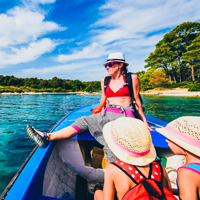Moving to San Pedro, Belize
Last updated on Feb 13, 2025
Summary: Moving to San Pedro, Belize? Expats talk about what you need to know before moving to San Pedro.
What do I need to know before moving to San Pedro?
When we asked people what advice they would give someone preparing to move to San Pedro, they said:
"Here's your best advice: No one can tell you what is right for you. The very simple answer is this - 1) come here and rent for 6 months. - you can always buy a ticket back in 2 months if you don't like it (yes, you would lose a little money, but not your life savings). It would be a vacation 2) While here, live as if you are living here full-time (in other words, you're not on an extended vacation, going out every night, etc. - go to the grocery store, the pharmacy, etc so you get a good "realistic feel" 3) Look around at properties to RENT (Don't buy yet). If you decide you want to stay, RENT A ONE YEAR LONG TERM 4) Go back home for AT LEAST 2 months (even if you rent for one year) - clear your head. Don't get a false "Fantasy island / dream life" in your head. Focus on the difference of places and then decide during your year here what you want to do for "life decisions" I always advise: "wade into the pool, don;t jump in the deep end". I've seen hundreds of people lose their life savings by making bad choices (apparently they have never been to another country, never traveled, maybe never seen the Caribbean Sea) and they turn into five year olds, make spontaneous, bad decision and ruin their lives (divorce, bankruptcy, etc.) - "Wade into the pool" The worst case in my advice is you lose a few thousand dollars and you have "a good cocktail party" story. In 6 months you will know whether it's for you , or not and whether you want to proceed," said one expat who made the move to San Pedro.
"San Pedro, is a popular destination for expats due to its tropical climate, beautiful beaches, and friendly locals. Before moving to San Pedro, it's important to understand the cost of living, which can be higher than in other parts of Belize due to its popularity as a tourist destination. The official language is English, making it easier for English-speaking expats to communicate. However, many locals also speak Spanish and Creole, so learning a few phrases in these languages can be beneficial. The healthcare system in Belize is not as advanced as in some Western countries, so expats may want to consider getting international health insurance. San Pedro is a small town, so while it offers a relaxed lifestyle, it may not provide all the amenities and entertainment options that a larger city would. The local cuisine is a mix of Caribbean, Mexican, and Mayan influences, with seafood being a staple. The weather is tropical, with a wet and dry season. The wet season, from June to November, can bring hurricanes. Public transportation is limited, so many residents choose to get around by golf cart, bicycle, or on foot. The local currency is the Belize Dollar, but US dollars are widely accepted. San Pedro is on Ambergris Caye, the largest island in Belize, and is surrounded by the second largest barrier reef in the world, making it a popular destination for diving and snorkeling. While crime rates are generally low, petty crime can be an issue, so it's important to take basic safety precautions. Finally, it's important to understand the visa and residency requirements before moving to Belize. The country offers a Qualified Retired Persons program, which allows certain individuals to live in Belize tax-free," explained one expat living in San Pedro, Belize.
How do I find a place to live in San Pedro?
We asked expats how they chose their neighborhood and found a place to live. They answered:
"Finding a place to live in San Pedro involves several steps. First, you need to determine your budget and the type of accommodation you're looking for. This could range from a small apartment to a large beachfront villa. Next, you should research the different neighborhoods in San Pedro to find one that suits your lifestyle and preferences. Some popular areas include the downtown area, the southern part of the island, and the northern part of the island. Once you have an idea of what you're looking for, you can start your search. There are several online resources that list properties for rent or sale in San Pedro, such as Belize Real Estate MLS, Century 21 Belize, and Ambergris Caye Belize Properties. These websites allow you to filter by location, property type, price, and other criteria. In addition to online listings, you can also work with a local real estate agent. They can provide valuable insight into the local market and help you find properties that may not be listed online. Once you've found a few potential properties, you should arrange to view them in person. This will give you a better sense of the property's condition, its proximity to amenities, and the neighborhood it's in. Before finalizing a rental or purchase, it's also a good idea to speak with locals and expats who live in the area. They can provide firsthand information about what it's like to live in San Pedro and may be able to offer advice or recommendations. Finally, once you've found a place you like, you'll need to negotiate the terms of the lease or sale and sign the necessary paperwork. If you're not fluent in Spanish, you may want to hire a translator or lawyer to help with this process. Remember, finding a place to live in a foreign country can take time and patience, so don't rush the process. Take the time to find a place that you'll be happy with for the long term," commented one expat who made the move to San Pedro.

GeoBlue is a trusted leader in international health insurance. Wherever your destination, GeoBlue can keep you and your family covered with the right health insurance. Get a GeoBlue Quote Today!

GeoBlue is a trusted leader in international health insurance. Wherever your destination, GeoBlue can keep you and your family covered with the right health insurance. Get a GeoBlue Quote Today!
What is a typical expat home or apartment like in San Pedro?
"A typical expat home or apartment in San Pedro, is often located near the beach, offering stunning views of the Caribbean Sea. These homes are usually designed to blend in with the tropical environment, featuring bright colors and open layouts to allow for natural light and air circulation. They often have spacious living areas, modern kitchens, and comfortable bedrooms. Many homes also come with outdoor spaces like balconies or patios, perfect for relaxing and enjoying the warm weather. Some luxury apartments may even have access to shared amenities like swimming pools, gyms, and barbecue areas. Despite the tropical setting, these homes are equipped with modern conveniences such as air conditioning, internet access, and cable TV. They are often located within walking distance to local shops, restaurants, and other amenities, making them convenient for daily living," remarked one expat who made the move to San Pedro.
What is the average cost of housing in San Pedro?
If you are thinking about moving to San Pedro, cost of living in probably a key consideration. Expats commented about the cost of housing:
"The average cost of housing in San Pedro can vary greatly depending on the location and size of the property. For a one-bedroom apartment in the city center, you might expect to pay around $800 to $1,000 USD per month. If you're looking at a three-bedroom apartment in the same area, the cost could rise to between $1,500 and $2,000 USD per month. For those interested in purchasing property, a one-bedroom house might cost around $150,000 USD, while a larger, three-bedroom house could be priced at around $300,000 USD. However, these prices can fluctuate based on the real estate market and other factors," explained one expat living in San Pedro, Belize.
Should I buy or rent a home in San Pedro?
If you have not spent a lot of time in San Pedro, you should rent before even thinking about buying. We asked expats there about the buy vs. rent decision:
"Whether to buy or rent a home in San Pedro, largely depends on your personal circumstances, financial situation, and long-term plans. If you plan to stay in Belize for a long period, buying a home could be a good investment. Belize has a growing real estate market, and owning a property could provide you with a potential return on investment in the future. However, buying a home also comes with responsibilities and costs, such as maintenance, insurance, and property taxes. It also requires a significant upfront investment. If you're not ready for these commitments, or if you're not sure how long you'll stay in Belize, renting might be a better option. Renting a home in San Pedro gives you more flexibility. It's easier to move if you decide to leave or if your circumstances change. It also allows you to avoid the costs and responsibilities associated with homeownership. In addition, renting can give you a chance to familiarize yourself with the area and the local real estate market before making a long-term commitment. You can take your time to find the perfect home to buy, if you decide to do so in the future. In conclusion, both buying and renting a home in San Pedro, Belize, have their pros and cons. It's important to carefully consider your personal situation and goals before making a decision," commented one expat who made the move to San Pedro.
What should I pack when moving to San Pedro?
We asked people living in San Pedro to list three things they wish they had brought and three they wish they had left behind. They responded:
"When moving to San Pedro, you should pack lightweight clothing due to the tropical climate, including shorts, t-shirts, and swimwear. Don't forget to pack a rain jacket or umbrella for the rainy season. Comfortable walking shoes, sandals, and water shoes are essential for various activities. Pack enough prescription medication for the duration of your stay, as well as a basic first aid kit. Include insect repellent and sunscreen to protect yourself from the sun and bugs. Bring your personal toiletries, although keep in mind that most items can be purchased locally. If you wear glasses or contact lenses, bring an extra pair and solution. Pack your important documents such as passport, driver's license, and medical records in a safe and accessible place. If you plan on cooking, consider packing some of your favorite spices or condiments that may not be available locally. Don't forget your electronics like your phone, laptop, and camera, along with their chargers. A power adapter may be necessary depending on your devices. Bring some cash for immediate expenses upon arrival, but remember that credit cards are widely accepted. Lastly, pack some items that remind you of home, like photos or small mementos, to help you settle into your new environment," explained one expat living in San Pedro, Belize.
 PassportCard Expat Health Insurance
PassportCard Expat Health InsuranceGet Quote
Never worry about paying your medical bills out of pocket again. The innovative PassportCard allows for a stress-free experience for all expat families, remote travelers, and workers. With a 24/7 customer service and an outstanding customer base of over 2 Million clients, it will feel like medical care at home. Get up to 10% off on your policy now.
 PassportCard Expat Health Insurance
PassportCard Expat Health InsuranceNever worry about paying your medical bills out of pocket again. The innovative PassportCard allows for a stress-free experience for all expat families, remote travelers, and workers. With a 24/7 customer service and an outstanding customer base of over 2 Million clients, it will feel like medical care at home. Get up to 10% off on your policy now.
Get Quote
What cultural faux pas should I try to avoid making in San Pedro?
We asked people in San Pedro if they could share any humorous cultural blunders they commited. For new expats, keep in mind that these incidents are an inevitable part of expat life. Learning to laugh about them is the key!:
"In San Pedro, it's important to respect the local customs and traditions. Avoid making derogatory comments about the country or its people, as Belizeans are very proud of their heritage. It's also considered rude to interrupt someone while they're speaking, so always wait for your turn to talk. Public displays of affection are generally frowned upon, especially in more traditional or rural areas. While Belizeans are known for their relaxed and laid-back attitude, it's still important to be punctual for appointments or meetings. Avoid discussing sensitive topics such as politics, religion, or personal finances unless you know the person well. It's also considered impolite to refuse food or drink when offered by a host. If you have dietary restrictions, it's best to explain them politely. Lastly, always ask for permission before taking photos of people, as some may find it intrusive or disrespectful," said one expat in San Pedro.
About the Author
 Betsy Burlingame is the Founder and President of Expat Exchange and is one of the Founders of Digital Nomad Exchange. She launched Expat Exchange in 1997 as her Master's thesis project at NYU. Prior to Expat Exchange, Betsy worked at AT&T in International
and Mass Market Marketing. She graduated from Ohio Wesleyan University
with a BA in International Business and German.
Betsy Burlingame is the Founder and President of Expat Exchange and is one of the Founders of Digital Nomad Exchange. She launched Expat Exchange in 1997 as her Master's thesis project at NYU. Prior to Expat Exchange, Betsy worked at AT&T in International
and Mass Market Marketing. She graduated from Ohio Wesleyan University
with a BA in International Business and German.
Some of Betsy's articles include 12 Best Places to Live in Portugal, 7 Best Places to Live in Panama and 12 Things to Know Before Moving to the Dominican Republic. Betsy loves to travel and spend time with her family. Connect with Betsy on LinkedIn.
Other Questions:
- What do I need to know before moving to San Pedro?
- What is a typical expat home or apartment like in San Pedro?
- What is the average cost of housing in San Pedro?
- How do I meet people in San Pedro?
- What do I need to know before retiring in San Pedro?
- What should I pack when moving to San Pedro?
- Where should I setup a bank account in San Pedro?
- Will I be able to find a job in San Pedro?
- What is life like as an expat in your area?
- What do people like (and dislike) about San Pedro?
- What type of social life can someone expect in San Pedro?
- What is the social scene like in San Pedro?
- What advice to expats in San Pedro have about housing?
- What are medical services in San Pedro like?
- Are healthcare and health insurance expensive in San Pedro?
- Is the cost of living in San Pedro high?
- What are the visa & residency requirements in San Pedro?
- Why do people move to San Pedro?



